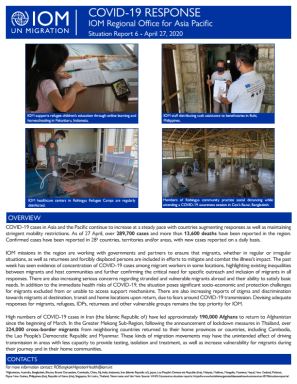-
Countries
-
Data and Analysis
-
Special Focus
-
Crisis Responses
IOM Asia Pacific Covid-19 Response - Situation Report 6 (27 April 2020)
COVID-19 cases in Asia and the Pacific continue to increase at a steady pace with countries augmenting responses as well as maintaining stringent mobility restrictions. As of 27 April, over 289,700 cases and more than 13,600 deaths have been reported in the region. Confirmed cases have been reported in 281 countries, territories and/or areas, with new cases reported on a daily basis. IOM missions in the region are working with governments and partners to ensure that migrants, whether in regular or irregular situations, as well as returnees and forcibly displaced persons are included in efforts to mitigate and combat the illness’s impact. The past week has seen evidence of concentration of COVID-19 cases among migrant workers in some locations, highlighting existing inequalities between migrants and host communities and further confirming the critical need for specific outreach and inclusion of migrants in all responses. There are also increasing serious concerns regarding stranded and vulnerable migrants abroad and their ability to satisfy basic needs. In addition to the immediate health risks of COVID-19, the situation poses significant socio-economic and protection challenges for migrants excluded from or unable to access support mechanisms. There are also increasing reports of stigma and discrimination towards migrants at destination, transit and home locations upon return, due to fears around COVID-19 transmission. Devising adequate responses for migrants, refugees, IDPs, returnees and other vulnerable groups remains the top priority for IOM. High numbers of COVID-19 cases in Iran (the Islamic Republic of) have led approximately 190,000 Afghans to return to Afghanistan since the beginning of March. In the Greater Mekong Sub-Region, following the announcement of lockdown measures in Thailand, over 224,000 cross-border migrants from neighboring countries returned to their home provinces or countries, including Cambodia, the Lao People’s Democratic Republic and Myanmar. These kinds of migration movements may have the unintended effect of driving transmission in areas with less capacity to provide testing, isolation and treatment, as well as increase vulnerability for migrants during their journey and in their home communities.
